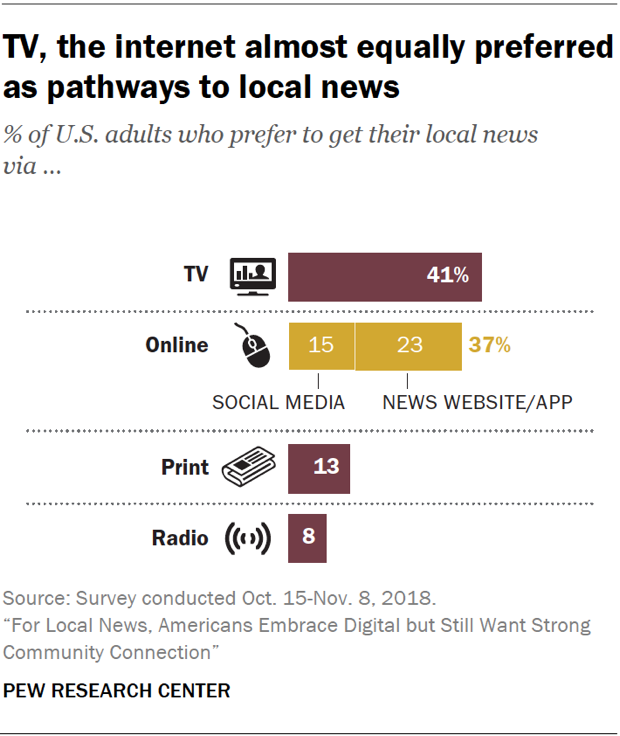
The digital environment is now a key component in how Americans learn about local events and issues in the news. Today, almost as many U.S. adults say they prefer to get their local news through the internet as prefer to do so through the television set.
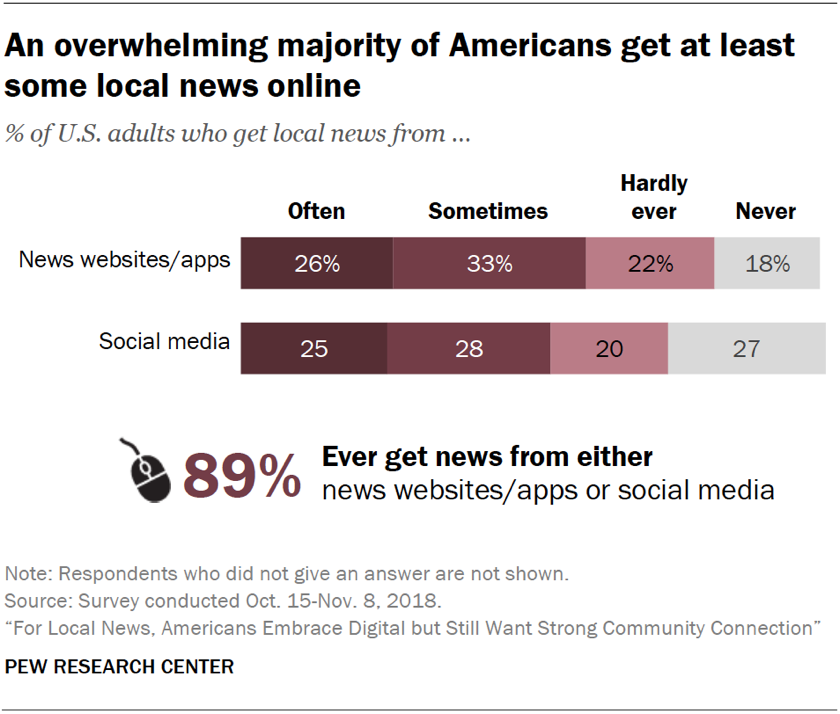
Specifically, when asked which pathways they prefer to use for local news – the television set, the internet (either through social media or websites/apps), print or radio – nearly the same portion of U.S. adults say they prefer an online method (37% total, including 23% who favor news websites or apps and 15% who name social media) as say they prefer television (41%). Far fewer prefer print newspapers (13%) or radio (8%). This close split between TV and online pathways tracks closely with how Americans access news more generally.
Beyond digital being the preferred pathway, 89% of Americans get at least some local news digitally and about four-in-ten (41%) do so often. This breaks down to about equal shares who often get local news specifically from social media (25%) and online news websites or mobile apps (26%).
Local TV stations remain the most relied-on individual source, despite having little online presence
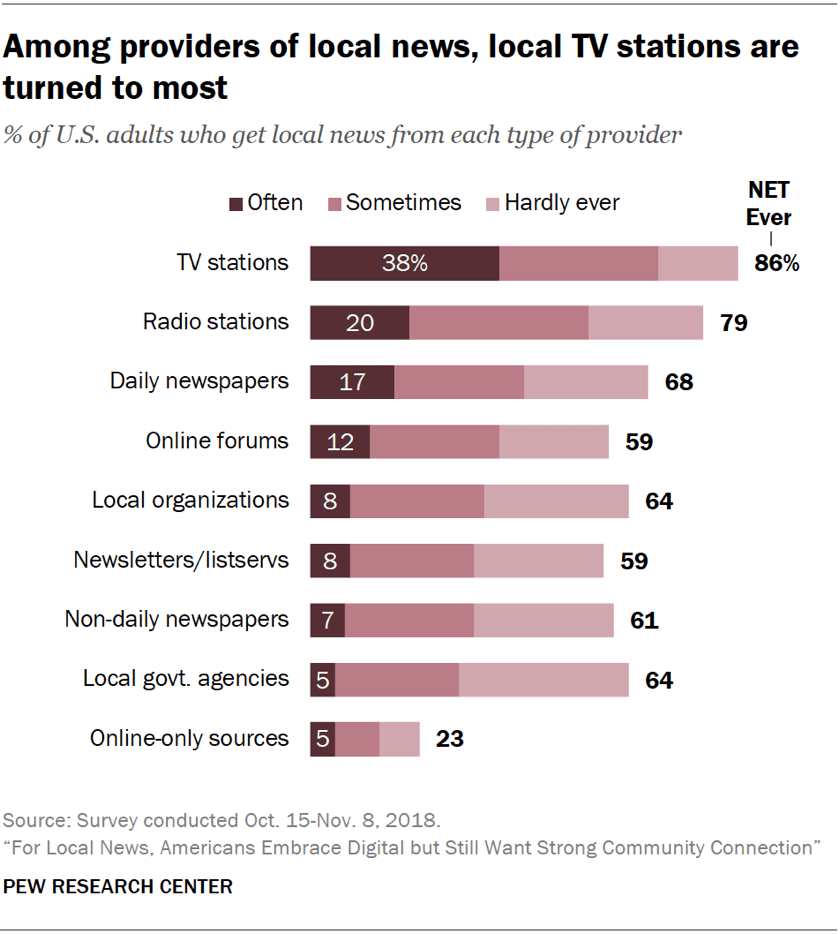
In addition to the various pathways used to get local news – online sites, apps, television, print and radio – consumers can turn to a growing range of specific sources. In most cases these sources now offer content through several pathways. For example, someone who turns to their local newspaper for news can access it in print, via its website or by following the outlet on social media.
To untangle this complex system, this study first asked respondents how often they get local news from each of nine different providers (such as local TV stations or community newspapers), and then asked how they tend to access that source (whether print, television, the internet, etc.).
The results show that local TV stations are the top type of source for local news. About four-in-ten Americans (38%) say they often get news from local TV stations (86% ever do so). Radio stations (from which 20% often get news) and daily newspapers (17%) serve as the next most popular providers of local news.
All in all, 28% of the public often gets news from at least one of six less traditional types of providers asked about here, and a vast majority – 89% – ever get news from at least one of them.
Many Americans turn to the online versions of local news providers
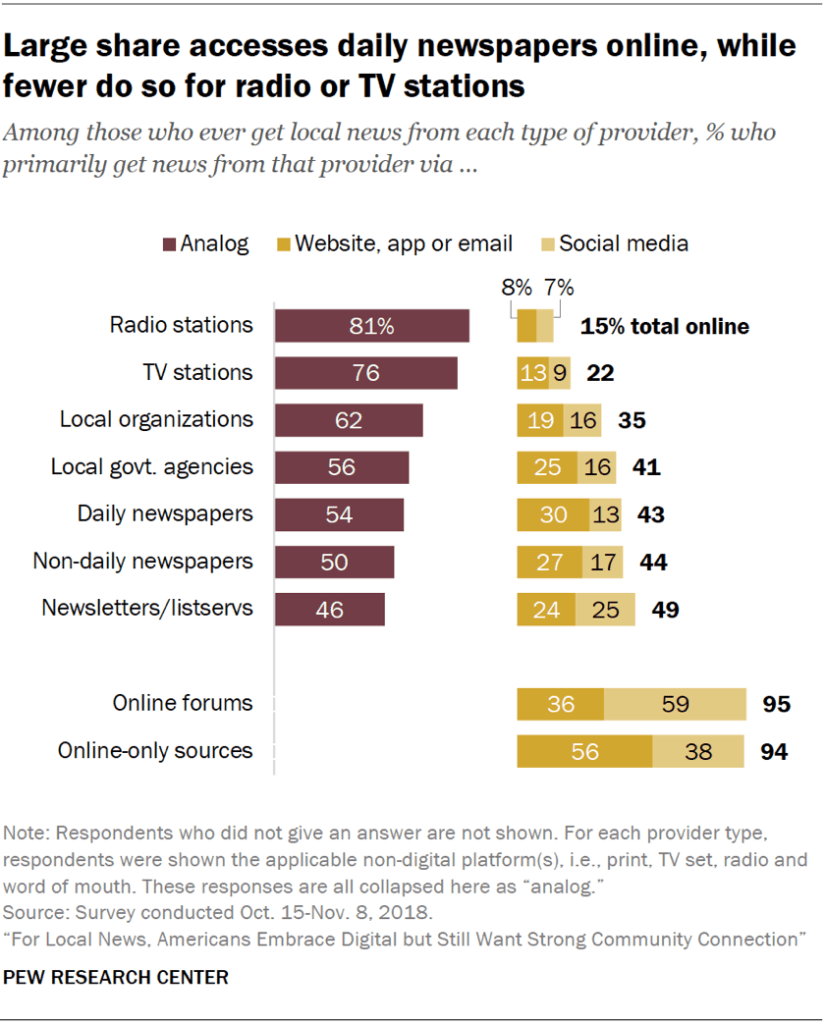
Even as TV stations are a powerhouse source for local news, they are still accessed primarily through the analog format of television sets; this is also true of radio news stations.3 Fully 76% of those who get news from local TV stations and 81% of those who get news from radio stations primarily go to these providers through the traditional pathway.
But other news providers have a substantial portion of their audience who access them online. Among those who get local news from daily newspapers, for example, 43% primarily access them online while 54% get them mainly in a print format. And nearly half of those who get local news from newsletters or listservs (49%) do so primarily online.
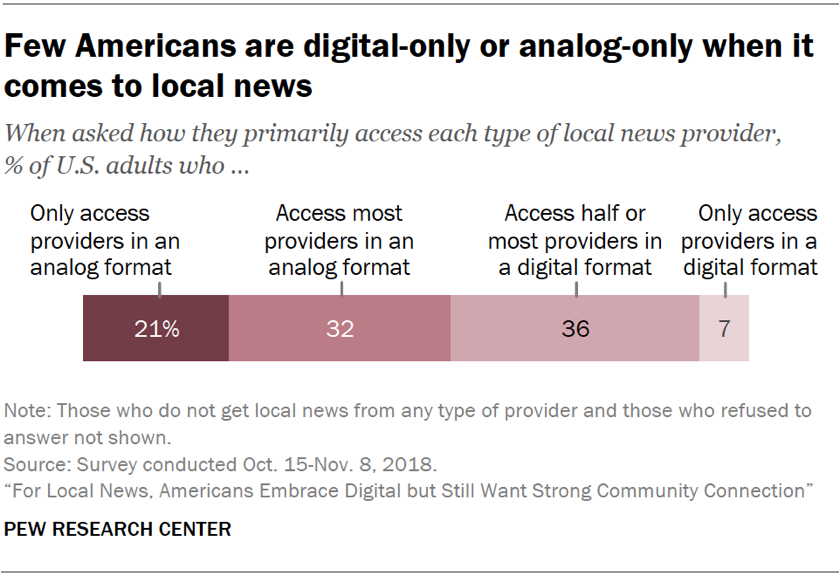
At the same time, few Americans are fully analog or fully digital in the way they get local news. Instead, most (68%) mix online and offline pathways, for example, turning on the TV set to watch their local news station but going online to read the daily newspaper and neighborhood listserv.
Just 7% of Americans indicate that they only use digital pathways as their primary access points. Three times as many U.S. adults (21%) mainly access all providers they get news from through an analog pathway – though this is still also a clear minority.
Minority of Americans often turn to multiple types of providers for local news
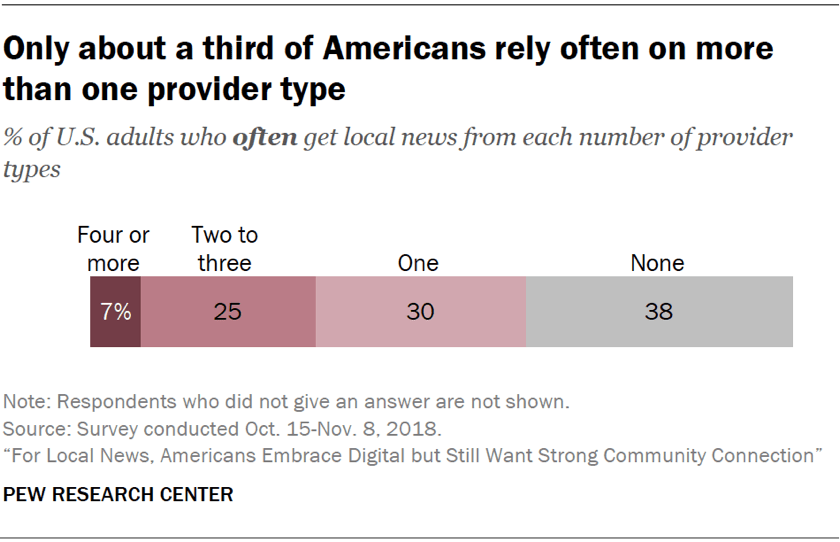
When it comes to Americans’ everyday news habits, most get their local news from a small number of sources. In fact, a sizable portion of the public doesn’t frequently turn to any sources: Nearly four-in-ten Americans (38%) don’t get news often from any of the nine provider types. Three-in-ten regularly rely on a single source type – most often local TV stations – and another 31% often get news from two or more types of sources.
Nonetheless, a large majority of U.S. adults (79%) get at least some news from four or more of the nine types asked about. In other words, while Americans may not frequently get local news from very many providers, their local news diets overall span a wide range of sources.
Infrequent local news consumers are more likely to turn to digital formats
In many cases, Americans who turn to local news providers more frequently are more likely to access them in analog form rather than digital. Conversely, infrequent news users are more likely than frequent ones to take a digital path.
For example, 90% of those who reliably turn to a local TV station do so primarily on a TV set. This drops to 71% among those who say they engage with local TV stations only sometimes, and 52% among those who say they hardly ever get news there. The remaining shares of each utilize digital options. A similar pattern holds for users of daily newspapers, radio stations and non-daily newspapers: Those who often get news there are more likely than less frequent users to opt for traditional means.4
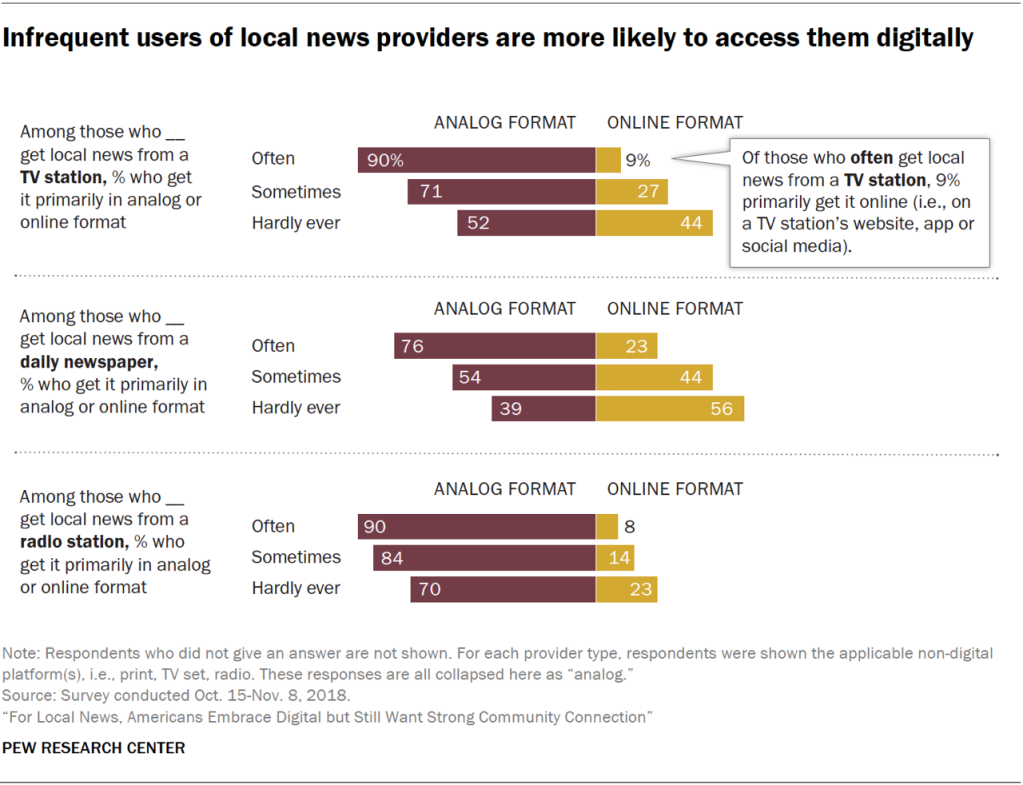

A similar dynamic comes through at a broader level. Roughly two-in-ten (21%) of those who prefer to get local news online tend to follow local news very closely, compared with 40% of those who prefer TV and 35% of those who prefer print. The few Americans who prefer radio are also less likely to follow local news very closely (19%).

Americans still rely on other people to keep them updated
Beyond media organizations and other information providers, it’s common to get local news from friends, neighbors and family – 90% do so at least occasionally, and 17% do so often. This largely happens by word of mouth (either face to face or over the phone) as opposed to through email, text or social media.
Many say the internet is an important source for local news; fewer say this of social media specifically
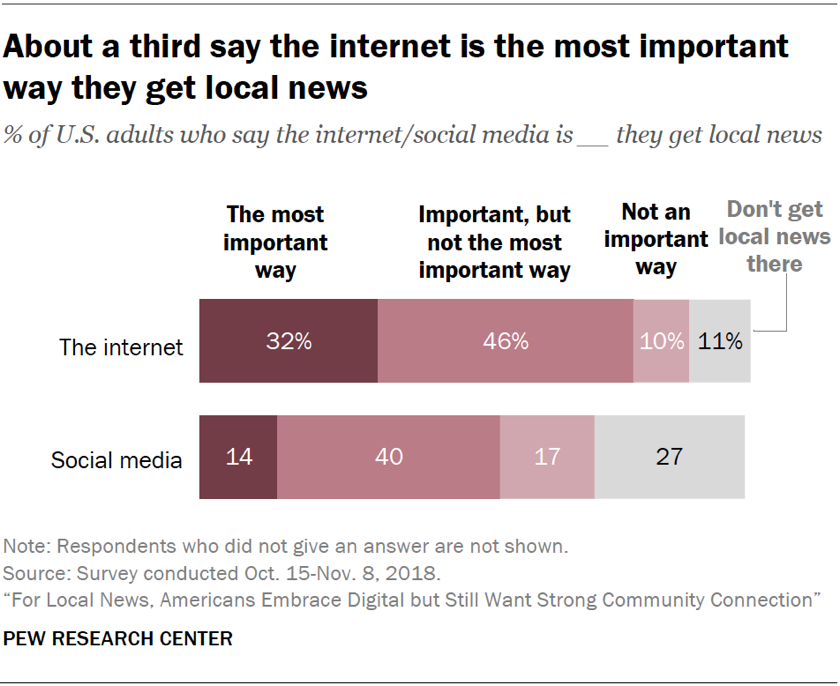
Most Americans see the internet as an important way of keeping up with local news, but fewer see it as critical. Overall, a large majority (77%) say the internet is important in how they get local news, but this drops to about a third (32%) who think it is the most important way. Just one-in-ten, on the other hand, say the internet is not important in getting local news, and a similar-sized share doesn’t use the internet to get news.
When it comes to social media specifically, more than half of Americans (54%) describe it as an important way they get local news, though 14% say it is the most important.
Mobile devices are far more popular than desktop computers for accessing local news online
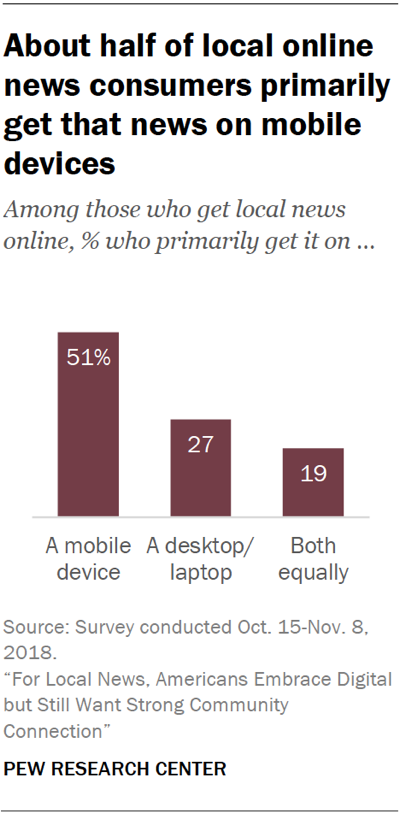
Of the 89% of Americans who get local news online, about half (51%) say they do so primarily through a mobile device; fewer name desktop or laptop computers (27%) and 19% use both equally. This follows patterns in how Americans get their news more generally, with mobile news use overtaking desktop in 2017.
News alerts are also a substantial part of the way people access local news on their phones – about four-in-ten U.S. adults (42%) get local news alerts on their phone.
Digital news consumers place high value on an easy-to-use website
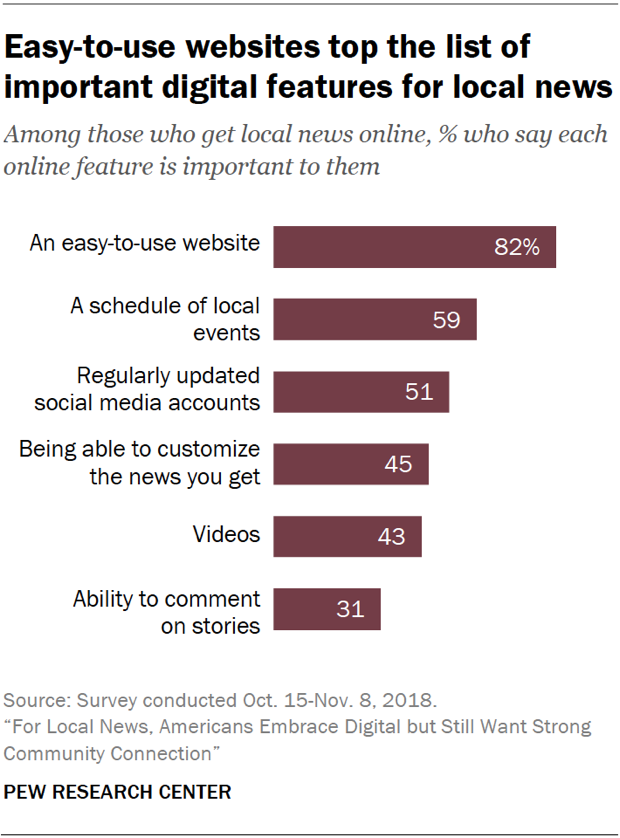
Within the digital news experience, more Americans place value on basic needs than on advanced digital features. A large majority of those who get local news online (82%) say that an easy-to-use website is an important feature of an online local news source. Fewer say other features are a priority – 59% say schedules of local events are an important feature, and about half (51%) say this of regularly updated social media accounts. Customizable news, videos and comment sections rank lower.
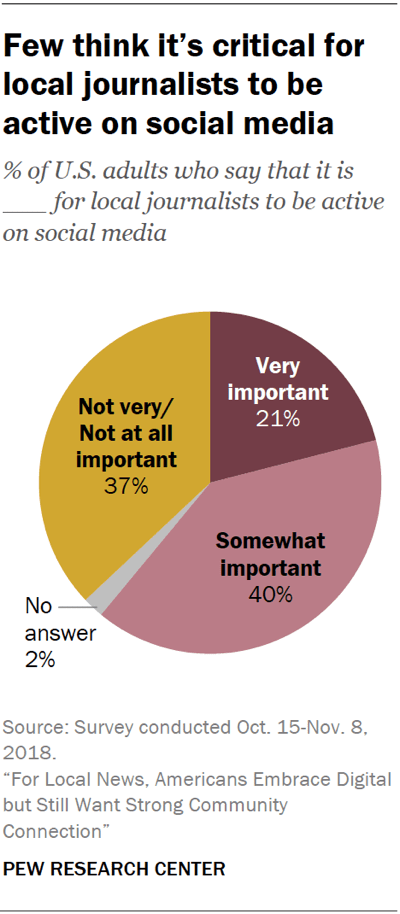
While about half of online news consumers appreciate outlets having a regularly updated social media account, few Americans place a high premium on local journalists using social media themselves. About one-in-five U.S. adults (21%) say it is very important for local journalists to be active on sites like Twitter and Facebook, while 40% say it is somewhat important. Roughly four-in-ten (37%) say it is not very or not at all important.
The reliance on social media as a pathway to local news raises the question of whether people notice the actual source of the local news they get from these sites. In fact, a majority of those who get local news from social media (64%) say they do pay attention to the sources they see on these sites.




